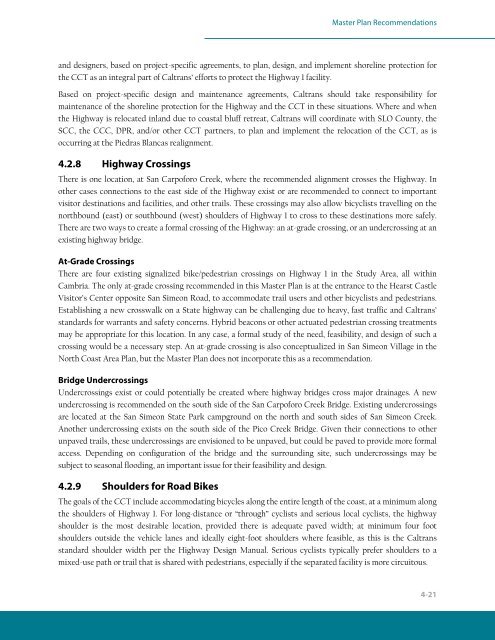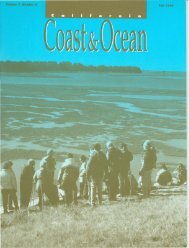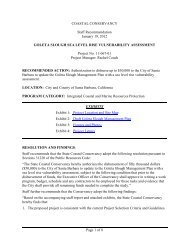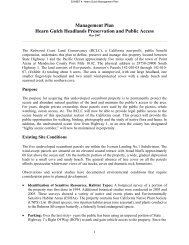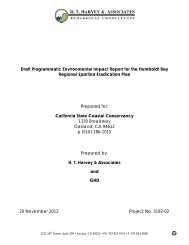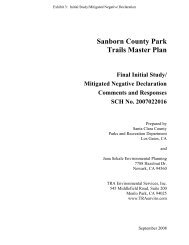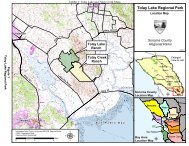Northern San Luis Obispo County Coastal Trail Master Plan
Northern San Luis Obispo County Coastal Trail Master Plan
Northern San Luis Obispo County Coastal Trail Master Plan
Create successful ePaper yourself
Turn your PDF publications into a flip-book with our unique Google optimized e-Paper software.
<strong>Master</strong> <strong>Plan</strong> Recommendations<br />
and designers, based on project-specific agreements, to plan, design, and implement shoreline protection for<br />
the CCT as an integral part of Caltrans’ efforts to protect the Highway 1 facility.<br />
Based on project-specific design and maintenance agreements, Caltrans should take responsibility for<br />
maintenance of the shoreline protection for the Highway and the CCT in these situations. Where and when<br />
the Highway is relocated inland due to coastal bluff retreat, Caltrans will coordinate with SLO <strong>County</strong>, the<br />
SCC, the CCC, DPR, and/or other CCT partners, to plan and implement the relocation of the CCT, as is<br />
occurring at the Piedras Blancas realignment.<br />
4.2.8 Highway Crossings<br />
There is one location, at <strong>San</strong> Carpoforo Creek, where the recommended alignment crosses the Highway. In<br />
other cases connections to the east side of the Highway exist or are recommended to connect to important<br />
visitor destinations and facilities, and other trails. These crossings may also allow bicyclists travelling on the<br />
northbound (east) or southbound (west) shoulders of Highway 1 to cross to these destinations more safely.<br />
There are two ways to create a formal crossing of the Highway: an at-grade crossing, or an undercrossing at an<br />
existing highway bridge.<br />
At-Grade Crossings<br />
There are four existing signalized bike/pedestrian crossings on Highway 1 in the Study Area, all within<br />
Cambria. The only at-grade crossing recommended in this <strong>Master</strong> <strong>Plan</strong> is at the entrance to the Hearst Castle<br />
Visitor’s Center opposite <strong>San</strong> Simeon Road, to accommodate trail users and other bicyclists and pedestrians.<br />
Establishing a new crosswalk on a State highway can be challenging due to heavy, fast traffic and Caltrans’<br />
standards for warrants and safety concerns. Hybrid beacons or other actuated pedestrian crossing treatments<br />
may be appropriate for this location. In any case, a formal study of the need, feasibility, and design of such a<br />
crossing would be a necessary step. An at-grade crossing is also conceptualized in <strong>San</strong> Simeon Village in the<br />
North Coast Area <strong>Plan</strong>, but the <strong>Master</strong> <strong>Plan</strong> does not incorporate this as a recommendation.<br />
Bridge Undercrossings<br />
Undercrossings exist or could potentially be created where highway bridges cross major drainages. A new<br />
undercrossing is recommended on the south side of the <strong>San</strong> Carpoforo Creek Bridge. Existing undercrossings<br />
are located at the <strong>San</strong> Simeon State Park campground on the north and south sides of <strong>San</strong> Simeon Creek.<br />
Another undercrossing exists on the south side of the Pico Creek Bridge. Given their connections to other<br />
unpaved trails, these undercrossings are envisioned to be unpaved, but could be paved to provide more formal<br />
access. Depending on configuration of the bridge and the surrounding site, such undercrossings may be<br />
subject to seasonal flooding, an important issue for their feasibility and design.<br />
4.2.9 Shoulders for Road Bikes<br />
The goals of the CCT include accommodating bicycles along the entire length of the coast, at a minimum along<br />
the shoulders of Highway 1. For long-distance or “through” cyclists and serious local cyclists, the highway<br />
shoulder is the most desirable location, provided there is adequate paved width; at minimum four foot<br />
shoulders outside the vehicle lanes and ideally eight-foot shoulders where feasible, as this is the Caltrans<br />
standard shoulder width per the Highway Design Manual. Serious cyclists typically prefer shoulders to a<br />
mixed-use path or trail that is shared with pedestrians, especially if the separated facility is more circuitous.<br />
4-21


